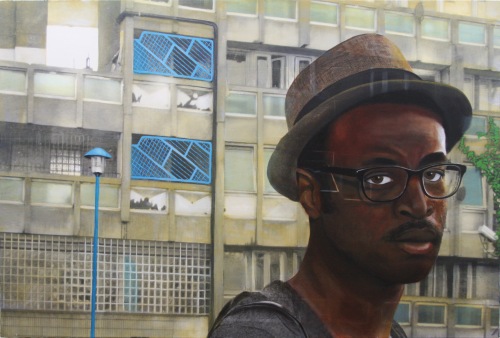Acrylic and oil on canvas.
From the series Open Windows: London architecture and architects
Wana Kejeh was born in Bermondsey, South London in 1984. Artistic from an early age, he studied architecture and worked in the architectural field for several years, before returning to art. He ran a gallery in Crystal Palace called the Weekend Gallery – so called because it was only a gallery on the weekends – during the week it was his father’s office for teaching English and business skills to recent immigrants. In 2012 I met him at my MFA degree show, where he invited me to show with him at the Weekend Gallery. The show was a success (I sold a painting!) and we struck up an enduring friendship.
Wana recently left London for Berlin, fleeing the high cost of living.
Eleanor: What is your background in architecture?
Wana: I studied at the University of Sheffield School of Architecture, based at the top of the famous Arts Tower. Back then the brutalist 60s building still had its original minimalist features. In my view there was no better place for a studio, the panoramic views from the 16th floor up were breathtaking. After my degree I worked for LRW [Leach Rhodes Walker] on various social projects including two schools in Ealing and a landscaping project at Tiverton Estate, Haringey. After a year I moved to Lloyd Northover to work on interior design projects.
E: What made you give up on architecture and return to painting?
W: I gave up on the industry when I found the reality of architectural design, especially in the current economic climate, to be restrictive and too commercially driven. I also found the profession to be too life-consuming. And I’m not the type of person to be tied down. I’ve always been an artist, since I was little. I opted to study architecture, rather than go to art school. At this point I was seventeen and my parents were the main influence in that decision. But my careers adviser and my A level art teacher advised me against it and it turns out they were right. Although I realise now that I can work with the extra skills I developed during my education and apply that to my art, so none of it was a waste.
E: You chose the Robin Hood Garden Estate as one of your favourite buildings in London. What does it mean to you?
W: Robin Hood Gardens, by Alison and Peter Smithson, is the ultimate symbol of the ‘Streets In The Sky’ concept. [Streets in the Sky was a style of 1960s-1970s British architecture. Built to replace run-down terraced housing, the new designs included inside toilets, and incorporated shops and other community facilities in the high-rise blocks.] Robin Hood Gardens is also endangered as it is due to be demolished in the coming years, likely to make way for luxury flats to increase land and property value. Cooper’s Road Estate in Bermondsey was my childhood home and it was erased when Southwark council demolished all the flats, so I am absolutely opposed to this form of social cleansing. I wanted to be captured with this building in the background before it was too late.
E: How would you like to see London develop architecturally?
W: London is a city of different sorts and impressive architecture. A lot of the interesting buildings, I find, were built during the massive building boom of the 60s and 70s, and I find concrete to be beautiful. Society and creativity used to be at the heart of design and the results are interesting and quirky. Nowadays economic conditions and budget squeezes are driving down the design quality of new builds, and it’s obvious by their appearance and the materials used. If they want to make cheap buildings why don’t they provide some of these as social housing? It is social housing that is preventing inner London from becoming homogeneous and void of that edge and creativity that made it attract people in the first place.
E: Why did you leave London for Berlin?
W: Since I first visited Berlin in 2003 I took an interest in its scene and its urban and natural landscape. The more I visited, the more friends I made and after a time it took my soul. I decided to take the leap when living in London as an artist became too unsustainable. In terms of architecture Berlin is not as attractive as London, but the stories behind the building styles and patterns have far more depth, particularly concerning the history of East and West Berlin. It is a city where you can be flexible and not worry about class or status. Everyone’s in the same boat, we are all refugees in one form or another, because we are all escaping something… Right now I’m painting in my large bedroom but eventually I’d like to occupy empty spaces and bring them into creative uses.

